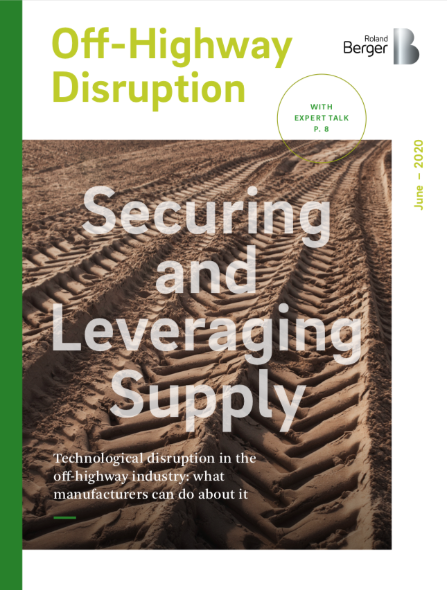E-Disruption in the Off-highway Industry
![{[downloads[language].preview]}](https://www.rolandberger.com/publications/publication_image/Roland_Berger_STU_614_E-Disruption_Cover_download_preview.png)
Roland Berger’s Securing and Leveraging Supply method helps off-highway manufacturers to assess the risks and opportunities of technological disruption.


"Although not as immediate as in passenger vehicles, electric disruption is already affecting off-highway vehicles."
Off-highway manufacturers of construction and agricultural vehicles are beginning to feel the effects of disruptions such as electrification. Navigating the supply-side economics of electric vehicles and assessing the risks and opportunities of a changing industry is no easy task. However, our white paper, “Off-Highway Disruption: Securing and Leveraging Supply”, details the framework that has been specifically developed to help off-highway manufacturers shield themselves from unforeseen risks.
Emission regulations tend to migrate from passenger vehicles (PVs) to commercial vehicles (CVs) to off-highway vehicles (OH). The adoption of new trends and technology, such as electric vehicles, follows a similar migration pattern. By 2025, 20 percent of all passenger vehicles sold in Europe and China are expected to be fully electric. Because PVs drive more than 90 percent of total volume in the automotive market, developments there impact the entire supply chain. This means that all OEMs are moving resources away from traditional parts and investing heavily in new technology. In addition, new suppliers are entering the field with a strong focus on power electronics and electric motors. This places OEMs in a perfect storm.
As pressure to reduce greenhouse gases at both construction and agricultural sites intensifies, off-highway manufacturers are strongly considering the transition to electric. Use of autonomous and connected vehicles is also on the rise as it could reduce total logistics costs and help to build platforms that improve operating efficiency. In the face of disruption, off-highway manufacturers may have to deal with curtailed investment or supply constraints. At the same time, they may need to identify partners to leverage potential technical developments that will be relevant for the off-highway segment down the line.
Roland Berger’s Securing and Leveraging Supply (SLS) is a proven methodology approach that helps off-highway OEMs evaluate risks and opportunities, and stay ahead of disruption before it’s too late. The SLS method secures supply by assessing market and individual supplier risk and evaluating potential mitigation steps, which could include equity investing in suppliers, re-sourcing or building in-house capabilities. On the leveraging supply side, it helps to identify opportunities for technology partnerships with suitable suppliers. OEMs need to increase flexibility to be able to adjust capacities to reflect the electric vehicle revolution and future-proof procurement strategies. The SLS approach is closely linked to the most relevant technology disruptions and commodity strategies, meaning it provides one of the most dynamic outlooks for the off-highway industry today.

![{[downloads[language].preview]}](https://www.rolandberger.com/publications/publication_image/Roland_Berger_STU_614_E-Disruption_Cover_download_preview.png)
Roland Berger’s Securing and Leveraging Supply method helps off-highway manufacturers to assess the risks and opportunities of technological disruption.
